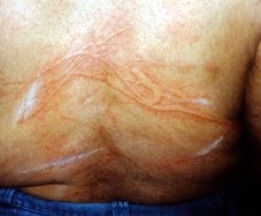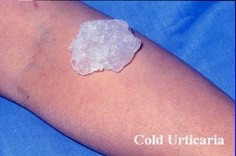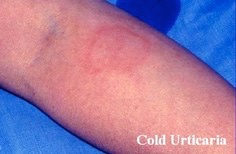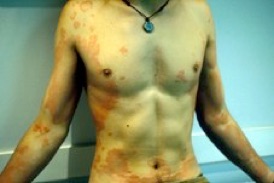Hives and Urticaria and angioedema

IMPORTANT The information provided is of a general nature and should not be used as a substitute for professional advice. If you think you may suffer from an allergic or other disease that requires attention, you should discuss it with your family doctor. The content of the information articles and all illustrations on this website remains the intellectual property of Dr Raymond Mullins and cannot be reproduced without written permission.
What are hives?
Hives (also known as urticaria) look like mosquito bites. They range from the size of a pinhead to that of a dinner plate. Although some unlucky individuals can have them every day for weeks, individual lumps usually go in minutes to hours. In most people, hives are not due to allergy.
How common are hives?
Approximately 1 in 6 people will develop hives some time during their life and are most common in children. They eventually disappear in most people. They may reappear following infection, when under stress or for no particular reason. Some will have recurrent hives on and off most of their life.
Hives occur in the skin
Underneath the lining of the skin, gut, lungs, nose and eyes are mast cells. These are designed to kill worms and parasites. Mast cells are like "land-mines", and contain "bags" filled with irritant chemicals including histamine. When these are released in small amounts, they cause local itch and irritation. In larger amounts, they will cause fluid to leak out of blood vessels, resulting in swelling of the skin. Occasionally, hives may not be itchy at all.
Can hives occur anywhere else?
Yes. Any part of the body can swell - hands, feet, face, even genital areas. Swelling of the lips and face is uncomfortable and cosmetically embarrassing, but is not dangerous. This is called angioedema, and is caused by similar swelling deeper in the tissues. Occasionally swelling of the tongue and throat may occur, but this is rarely dangerous in those without an allergic cause. Occasionally the swellings will occur inside the stomach and cause tummy pain or cramps or even chest pain when the hives are at their worst.
Can hives be dangerous?
Hives on the outside don't harm us. They are not damaging inside organs like kidneys, liver or lungs. The only danger is if the tongue swells or the back of the throat swells severely. Since this can cause difficulty breathing, this is a symptom that needs to be taken seriously. Urgent medical treatment is required if this occurs.
Are hives always itchy ?
Usually, but not always ! Occasionally, swelling in the deeper layers of skin (known as "angioedema") can even be painful or burning, particularly when it occurs over joints. These sometimes last for days.
Are all hives allergic?
With the exception of drug allergy, hives due to insect stings or food allergy rarely last more than a day. So someone complaining of hives lasting days or weeks at a time, or frequent hives, rarely have allergy as the cause.
Hives are rarely caused by terrible disease
Hives are rarely due to a nasty underlying disease. They may make you miserable on the outside but are not normally causing any damage internally. Common causes include infection (particularly in young children), or contact with animals or plants. Allergic reactions to food, pain killers (such as aspirin or arthritis tablets like ibuprofen, naproxen, diclofenac) or antibiotics can also trigger hives, with onset usually within an hour of exposure.. Sometimes insect stings, food additives or preservatives can trigger hives. Stress can certainly make established symptoms worse, but is a very rare cause.
What diseases are associated with hives?
Infection in the major trigger, especially in young children. That can cause problems when someone gets and infection, then is given and antibiotic and then later gets hives a day or two later. What is the cause? The infection or the drug? Thyroid disease is also more common, especially those with long lasting symptoms. Some studies suggest celiac disease may be more common or autoimmune disease as well. Low vitamin D has been associated with more prolonged hives and there are studies of vitamin D supplementation in those who have low vitamin D showing benefit. but in the vast majority of people, all tests are normal and one is never sure of why. Still, it is better to have hives alone than a disease to go with it!
When to worry more...
Ordinary hives do not make you sick, lose weight, get sore joints, get nights sweats or high fevers or bruising. Such symptoms, especially in young children, may be a sign of so-called auto-inflammatory disorders and are a good reason to seek medical attention.
Most people with urticaria do not need tests
Tests are sometimes done when hives go on for long periods or when unusual symptoms are occurring around the same time. This is to exclude other diseases, which may appear as hives first and other conditions later. Allergy testing is performed when the history suggests of an allergic cause. Allergy testing is rarely required when episodes of hives are prolonged.
There are circumstances when tests are required to rule out underlying disease or help exclude conditions that can look like hives. Examples include some cases of prolonged hives, when the person is unwell/sick (as hives may make you itchy and tired, but rarely "unwell"), or when there are unusual features like lumps lasting for days at a time or bruising. Under these circumstances, blood tests and sometimes a skin biopsy (tissue sample) may be performed to exclude conditions like urticarial vasculitis .
"Ordinary" hives don't make you sick
Hives may make people tired due to lack of sleep, but not "sick". They are not affecting you internally or interfering with essential organs like liver or kidneys. The only danger of "routine" hives is if the tongue or throat swell and cause difficulty breathing, a condition known as angioedema (see below).
Types of Hives
It may surprise you to learn that there are many different types of hives. Whilst most people have their lumps and bumps come up spontaneously without any clear triggers, others find that things that they eat, drink or do can make them appear more often. For example, there is a group of conditions known as the "physical urticarias". These hives come out with various physical stimuli to the skin. Symptoms occur alone or accompany spontaneous hives. While there is rarely an important underlying disease, exceptions occur. For example, solar urticaria has been associated with a rare condition called hypereosinophilia syndrome, and occasionally SLE/lupus.
Examples of the "physical urticarias" include
Cold: Cold air, immersion in cold water, cooling of the skin while sweating (uncommon). The major significance of this condition is the risk of severe allergic reaction with whole body cooling such as when swimming in cold water. There is a small risk of drowning if severe dizziness or blackouts occur when swimming alone.Wearing a MedicAlert bracelet and telling surgeons and anaesthetists before surgery is important so a person can be kept warm during surgery.
Heat: Contact with hot objects or food (rare)
Aquagenic: Hives occur upon contact with water (rare)
Solar: Hives occur upon exposure to sunlight (rare)
Vibration: e.g. using lawnmower or power tools (rare)
Delayed Pressure: Occurs several hours after leaning on elbow or carrying heavy bags or sitting on a hard seat (uncommon)
Dermographism: Hives occur when the skin is rubbed or scratched, or when irritated by tight clothing (very common, around 1/600 people)
Cholinergic: Red blotchy areas with or without small pimple-sized lumps occur when people sweat e.g. exercise, stress, saunas, after alcohol, spicy food (very common, perhaps up to 5% of adolescents transiently).
Angioedema can occur on its own
Angioedema occurs in around 1 in 3 people with hives. It is caused by similar swelling deeper in the tissues. Angioedema is not always itchy and can sometimes be painful. Sometimes it can occur on its own. As well as in infection and allergy, angioedema is also seen in two other situations. Around 1 in 100 people taking heart/blood pressure medicines called ACE (Angiotensin Converting Enzyme) inhibitors will develop angioedema.
The tendency to angioedema can be inherited
Hereditary angioedema (HAE) occurs in around 1 in 50,000 people. Patients lack an effective enzyme (known as C1 esterase), which is associated with non-itchy swellings of the face, throat or limbs. Swelling of the gut is a common symptom, resulting at times in severe abdominal pain and sometimes unnecessary surgery. See links for more information: https://allabouthae.com.au and https://haeaustralasia.org.au and https://www.allergy.org.au/hp/papers/hereditary-angioedema
How long do hives last?
Most hives go away within days to a few weeks. Occasional unlucky individuals will have itches and swellings that come and go over many years. Fortunately, that is the exception rather than the rule! If you have had symptoms for a couple of months already, then around 50% do in 6 months and about 80% go in a year, leaving around 20% who have even longer lasting symptoms.
Treatment of urticaria and angioedema
Time is a wonderful healer. Most resolve within a couple of weeks.
Avoid aggravating factors. Non-specific measures such as avoiding excessive heat, spicy foods or alcohol are often useful.
Aspirin and similar pain killers can make hives dramatically worse in around 1 in 3 people. These are best avoided unless you are already taking and tolerating them.
Medication. Medicines like antihistamines are often used to reduce the severity of the itch. Severe throat swelling requires early use of medication and attention by your doctor or in hospital. Adrenaline (epinephrine) by injection can be used if there is a significant risk of dangerous throat swelling. Other medicines (like cortisone tablets) may be needed if symptoms are severe. The main thing to realise is that drug do not cure hives; they just make you feel better until mother nature helps to take it away. When antihistamines do not work and symptoms are severe, there are a large number of other medications which can be tried to control symptoms. Some require regular blood tests to check for side-effects. More recently, an anti-IgE monoclonal antibody injection called Xolair is available in Australia to treat severe and unresponsive hives, although there are many hoops to jump through in order to obtain subsidised approval.
Special diets. Occasionally, going on a restricted elimination diet will help. Unfortunately, one cannot predict who will or will not respond to diet on the basis of history or allergy testing. The only way to sort it out is to put people on a temporary "elimination diet" under close supervision, followed by challenges if it helps. Even then, the mechanism remains unclear.
Last reviewed 15 August 2020
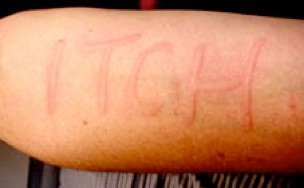
Dermographism

Spontaneous hives
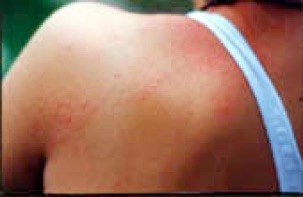
Cholinergic (sweating) hives/urticaria

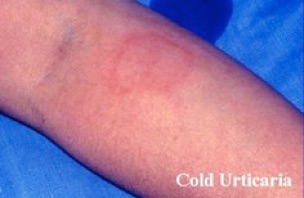
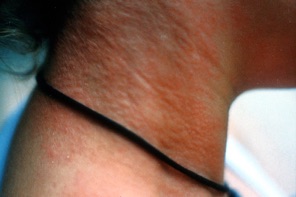

References
Mullins RJ. How to investigate the patient with urticaria. Modern Medicine April 1998: 119-127.
Weiner J. Understanding urticaria: and allergist's viewpoint. Current Therapeutics 1997; 29-35.
Mortureux P et al. Acute urticaria in infancy and early childhood. Arch Dermatol 1998; 134: 319-24.
Bilbao A et al. Urticaria in relation to infections. Allergol Immunopathol (Madr) 1999; 27: 73-85.
Charlesworth EN. Urticaria and angioedema: a clinical spectrum. Ann Allergy, Asthma Immunol 1996; 76: 484-96.
Greaves MW. Chronic urticaria. N Eng J Med 1993; 332: 1767-72.
Ormerod AD. Urticaria: recognition, causes and treatment. Drugs 1994; 48: 717-30.
Stewart JH; Goodman MM. Earthquake urticaria.Cutis 1989; 43:340
Shelley WB; Shelley ED Adrenergic urticaria: a new form of stress-induced hives.Lancet 1985;2:1031-3
Antia C, Baquerizo K, Korman A, Bernstein JA, Alikhan A. Urticaria: A comprehensive review: Epidemiology, diagnosis, and work-up. J Am Acad Dermatol. 2018 Oct;79(4):599-614. doi: 10.1016/j.jaad.2018.01.020. PMID: 30241623.
Maurer M, Metz M, Brehler R, Hillen U, Jakob T, Mahler V, Pföhler C, Staubach P, Treudler R, Wedi B, Magerl M. Omalizumab treatment in patients with chronic inducible urticaria: A systematic review of published evidence. J Allergy Clin Immunol. 2018 Feb;141(2):638-649. doi: 10.1016/j.jaci.2017.06.032.
Imbalzano E, Casciaro M, Quartuccio S, Minciullo PL, Cascio A, Calapai G, Gangemi S. Association between urticaria and virus infections: A systematic review. Allergy Asthma Proc. 2016 Jan-Feb;37(1):18-22. doi:10.2500/aap.2016.37.3915.
Holm JG, Ivyanskiy I, Thomsen SF. Use of nonbiologic treatments in antihistamine-refractory chronic urticaria: a review of published evidence. J Dermatolog Treat. 2018 Feb;29(1):80-97. doi: 10.1080/09546634.2017.1329505.
Kudryavtseva AV, Neskorodova KA, Staubach P. Urticaria in children and adolescents: An updated review of the pathogenesis and management. Pediatr Allergy Immunol. 2019 Feb;30(1):17-24. doi: 10.1111/pai.12967.
Radonjic-Hoesli S, Hofmeier KS, Micaletto S, Schmid-Grendelmeier P, Bircher A, Simon D. Urticaria and Angioedema: an Update on Classification andPathogenesis. Clin Rev Allergy Immunol. 2018 Feb;54(1):88-101. doi:
10.1007/s12016-017-8628-1.
